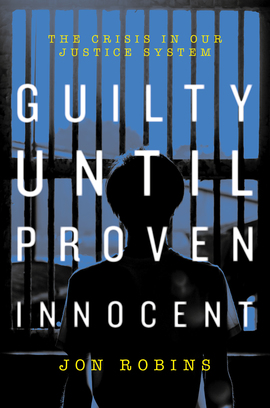Book review: Guilty until Proven Innocent, by Jon Robins
Jon Robins anatomises a criminal appeals system that appears to prioritise public confidence over individual fairness, that only grudgingly admits miscarriages of justice and that, even then, fails to compensate its victims unless they prove the very innocence they were presumed to have had in the first place.

The latest episode of the Australian radio programme and podcast The Law Report considers the question of compensation for wrongful convictions, comparing the situation there with that in other common law jurisdictions. Interviewed on the programme, author Jon Robins explains how, in England and Wales, a person whose conviction has been quashed on appeal is only entitled to compensation if they can prove, beyond reasonable doubt, that they were in fact innocent. This test, introduced by a change in the law in 2014, was recently upheld by the UK Supreme Court in the cases, heard together, of two such appellants: Sam Hallam and Victor Nealon. In both cases, compensation was denied because they could not prove their innocence. Their cases are among those discussed in this book, though it predates the Supreme Court’s decision in R (Hallam) v Secretary of State for Justice (JUSTICE intervening) [2019] UKSC 2; [2019] 2 WLR 440.
The book highlights the “crisis in our justice system”, and the way the “golden thread” of the presumption of innocence has been frayed ever thinner in recent years, by politicians wanting to be tough on crime and by a judicial establishment that remains complacent about the failings of the system and seems to regard the victims of miscarriages of justice as “collateral damage”.
Robins was prompted to write it to mark the 20th anniversary of the founding of the Criminal Cases Review Commission (CCRC), the state-funded “miscarriage of justice watchdog” set up following a recommendation of the royal commission that followed the release of the Birmingham Six. One of the most shocking things to emerge from that case was the blood-freezing observation of a senior law lord that “It is better that some innocent men remain in jail than the integrity of the English judicial system should be impugned”. That Lord Denning was by then more than a little past his prime does little to reassure those who still celebrate the elegant and inventive judgments of his better days. Such a fundamental bias might not affect his decisions on equity, tort and land law, but it makes you wonder. And it cannot have been unique amongst the judiciary of his era.
There is in the justice system, Robins says, a form of “extreme institutional denial” which
“From the Birmingham Six to the 1989 Hillsborough football stadium tragedy … has done more to undermine public confidence than the begrudging confirmation that the police really did beat confessions out of innocent Irish men or, in the case of Hillsborough, falsely made out grieving football fans to be drunken, ticketless louts who invited tragedy upon themselves.”
Safety net
The 1974 Birmingham pub bombings are back in the news again, after the reopening of inquests into the deaths of those who died in the two blasts. The scandal of the wrongful convictions and years of imprisonment of the six initially accused has never gone away, and along with a number of other notorious miscarriages of justice continue to haunt a criminal justice system which is now labouring under a host of other problems, the most fundamental of which is a critical lack of funding. Nor is the CCRC immune from this: Robins tells us that funding for this “safety-net mechanism” has fallen to just 40% of the amount provided a decade ago.
The CCRC receives around 1500 applications a year, mainly from prisoners. It refers two or three cases each month to the Court of Appeal. About two thirds of these referrals result in convictions being quashed or sentences reduced. But its work is continually undermined, “first by politicians and then by the Court of Appeal”. Even in the rare cases where the Court of Appeal quashes a conviction, the onus remains on the victim of the miscarriage of justice to prove their innocence in order to qualify for any sort of compensation.
The creation of the CCRC has also, says Robins, “usurped the role of others who previously investigated miscarriages of justice and, as a result, this failure of our justice system has gone largely unreported”. That said, other organisations do exist, such as the Centre for Criminal Appeals and various college-based Innocence Projects (although Robins is not optimistic about their effectiveness). However, he is right about the under-reporting of miscarriages of justice. It tends to require a well-organised campaign, such as that in relation to joint enterprise, to have any major effect. (Moreover, despite the critical decision by the Supreme Court in R v Jogee [2016] UKSC 8; [2017] AC 387, the follow-up cases on joint enterprise have generally not been successful on referral back to the Court of Appeal.) As for the press, they are more likely to highlight the costs to the taxpayer of an appellant’s legal aid, or the misery of the victims of the original crime, than to point out that someone wrongly convicted of it might themselves be a victim of a broken system.
The stories told in this book include those of Eddie Gilfoyle, convicted of engineering his wife’s apparent suicide; Danny Major, a police officer convicted of assaulting a suspect who died in custody; Omar Benguit, convicted of killing a Korean student on the fantastical evidence of an unreliable junkie; Tony Stock, convicted of a robbery whose actual perpetrators say he didn’t do; the former MP Harvey Proctor whose life was turned inside out by the hysterical Operation Midland fiasco; the parents of baby Effie Stillwell, wrongly accused of her “non accidental injury”; Sam Hallam, grudgingly exculpated of a gangland killing for which he was convicted at the age of 17; Victor Nealon, whose conviction for a sexual assault was quashed after DNA evidence identified another assailant.
The chapters read in part like detective stories, in part like polemical essays. Certain themes run through all the stories. Shambolic police investigations; failures by police and prosecutors to disclose unused material; reluctance by the Court of Appeal to consider any evidence available but overlooked at the time, or to review the factual (rather than legal) basis of a conviction; pressure on politicians to seem tough on crime at the expense of fairness and justice; the prejudicial effects of media sensationalisation of crime stories; and so on. Does all this add up to a “crisis in our justice system”? Robins makes a good case for it, although his analysis primarily focuses on cases that have gone wrong, rather than the system as a whole.
Transparency and accountability
One point bears highlighting because it relates to an issue about transparency and accountability. This is the difficulty of getting hold of recordings or transcripts of trial hearings and judges’ summings up. It’s a problem that bedevils any attempt to investigate a historic case which might have resulted in a miscarriage of justice. The problem is not that the trials are not recorded. Like so much else in public and official life, where the public are constantly under scrutiny from CCTV and their personal details are kept on files, trials in open (and closed) courts are recorded. But owing to an official policy those recordings are not retained beyond a surprisingly short period, formerly five years, now seven. Under Ministry of Justice guidelines, known as the Crown Court Record Retention and Disposition Schedules, the recordings (previously on analogue tape, now digital) are simply destroyed after that period. Any resource implications that may have applied in the case of physical tape recordings surely cannot survive the transition to digital technology.
So basically any conviction more than seven years old faces this additional hurdle to reinvestigation, that the oral evidence and the judge’s summing up to the jury can no longer be retrieved and scrutinised for error. This amounts to a limitation period on public accountability of the justice system.

Guilty Until Proven Innocent The Crisis in Our Justice System, By Jon Robins (Biteback Publishing, £12.99)
Featured image by Vojtech Okenka via Pexels.